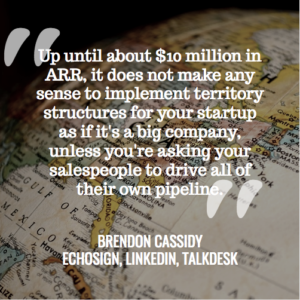We talk a lot here on SaaStr about the challenges of building out your sales team and the mistakes we all tend to make along the way. In this session three seasoned VPs of Sales from exemplary SaaS companies discuss what it takes to source and grow a sales team. Brendon Cassidy (EchoSign/LinkedIn/TalkDesk) chats with Mandy Cole (Stella & Dot/Zenefits) and Sam Jacobs (Livestream) about hitting quotas and attracting the right customers.
The session answers our most burning questions – When is the right time to hire your first sales rep? How do you find people that will fit in with the organizational culture? Do experience and skill trump personality and intellectual curiosity? What should you keep in mind if you hire millennials? And why do D2 college athletes make for excellent reps? Brendon, Mandy, and Sam answer all of these questions and more.
Check out the full transcript below!
If you want to see more sessions from 2016, we’re releasing a new one each week. Subscribe here to be notified. And be sure to grab your tickets to the 2017 Annual NOW.
TRANSCRIPT
Announcer: Let’s introduce the panel, ladies and gentlemen. Again, your moderator, Brendon Cassidy, VP of Sales from EchoSign, Talkdesk, LinkedIn. Mandy Cole, VP of Sales from Zenefits, and we have Sam Jacobs, SVP of Sales and Marketing at Livestream.
Brendon Cassidy: Hey, everybody. How are we doing today? My name’s Brendon Cassidy, as introduced, former VP of Sales, LinkedIn, EchoSign, Talkdesk, recently HackerRank.
With us is Mandy Cole, VP of sales with Zenefits. Prior to that, LivingSocial, and then Sam Jacobs, SVP of Worldwide Sales and Marketing for Livestream.
Today, we’re talking about how, when, and where to build a sales organization, and we’re looking forward to having that discussion. We’ll start off with a few questions, and I’ll start with Sam. When is the appropriate time to start a sales team?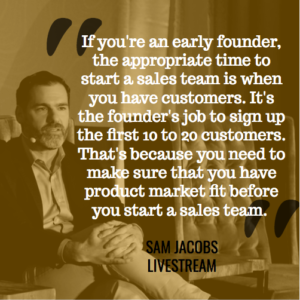
Sam Jacobs: The appropriate time to start a sales team, if you’re an early founder, is when you have customers. We were just talking about this off stage. It’s the job of the founder to sign up essentially the first 10 to 20 customers. That’s because the important thing to do before you start a sales team, you hire your first rep, is you need to make sure that you have product market fit.
Some of these things are cliches, but they’re true. The product has to serve a need. It has to meet the needs of the customers. The customers have to be willing to pay money for it.
The problem that I’ve seen and that I’ve experienced in my career, when you hire somebody like me, like Mandy, or like Brendon, what I do is I give companies revenue. If the product isn’t a good fit for the customer set, I’m going to probably find a way to give that revenue to the company anyway. The sacrifice is going to come in the LTV, the churn dynamics, and essentially the net promoter and delightion, as Dharmesh Shah said yesterday, in the customer’s success and feedback itself.
It’s really, really important that before you build a sales team, you’re ready. The customers are telling you that the product works. They want to renew. They’re happy with it. The founder has done those sales on his own or her own, or the team has done it on their own, so that it makes sense to begin to monetize and commercialize. Once you start it tends to be hard to stop.
What do you think, Mandy?
Mandy Cole: I agree. It also helps to just think about the end-to-end customer experience. I’m sorry. This just happened this morning. Murphy’s law. Making sure you have all those pieces in place, to your point. If you can sell people, but you can’t on board them, you can’t retain them, you don’t understand what their challenges are in month two, three, four, it’s going to be hard to prepare for that.
It also then helps you understand what type of person you want to hire. A lot of times, you don’t need to hire somebody as your first VP. You may need a director level, or maybe you hire an AE first, and then make sure, but understanding what the sales cycle is like, and really making sure you price it right, and like you said, that there is market opportunity, and where are you going to target first will also help you determine who’s your next hire.
Brendon: So you’re a founder. You have product market fit. You’ve stepped in as your first sales guy essentially. You have some customers, some recurring revenue. At that point, do you hire VP of sales, or do you bring in a couple salespeople first? What would be your advice to a founder?
Sam: Jason’s written a lot of articles about this. I don’t think that’s the right time to hire a VP of sales. You bring in a couple reps. There’s math associated with when to start doing this, so hopefully you have leads, and that’s the nature of product market fit is maybe your customers are talking to people that are not your customers about the quality of the product, so if you… and Tomasz Tunguz was up on the other stage, was talking about this just now.
There’s a fundamental unit of sales and marketing investment, that it’s not just the sales person. It’s the number of leads that are required to support that sales person. So you need to understand the economics of your business, what price point you’re going to set. Then you can hire sales people, but you just have to understand that they need some kind of leads, either through an outbound SDR and prospecting, or through some kind of inbound process, maybe through SEO or content generation.
They need to create a certain number of opportunities and close those opportunities at a certain rate over the course of their time with you, and if you don’t have enough leads to create those opportunities to win those deals, then you may not be ready to hire that team, or you’ll need an outbound SDR to begin to develop those leads.
Brendon: Mandy, and again, I think some of these are common sense. Some of these are consistently gotten wrong by founders, [laughs] and will be gotten wrong tomorrow no matter what we tell them, but you’re CEO, again, excited, and just raised a seed round or an A round. You have no leads, but you do have some revenue. Do you hire an AE, or do you hire an SDR?
Mandy: It depends on if they’re inbound leads or not. How much have you done around trying to attract inbound leads? Do you have people already coming in, because if you do, you can use that to figure out that same pipeline that Sam was just talking about. How many do you need? An inbound pipeline will look different from an outbound pipeline. Are they the people that you want coming in? Do you have that messaging right?
If you’re comfortable with closing a few of those, I would…an SDR is an easier person to get up to speed, and to actually help you task that market opportunity before you bring in a closer, because bringing somebody in that expects to be fed and isn’t getting fed because you’re still figuring that out, can be not an optimal situation.
Brendon: No leads, no salespeople. Think that’s the lesson. Sam, we were talking yesterday. I’m a big proponent of, when you’re a VP of sales, you want to bring in three to five people, that you know, probably have worked for you in the past. Sort of in network probably, from the last place you worked. Those of us who work in California are…everybody knows non competes are not enforceable in California…
[laughter]
Brendon: So that element is not considered legal risk here for us, but Sam brought up a good point, which is, if you’re not in California, non competes are actually legally enforceable. [laughs] So, you can’t actually recruit maybe the team that worked for you at your last company. If that’s the case, what do you look for when hiring those first few reps, really from the ground floor. How do you bring that mix in?
Sam: This is just continuing our conversation that’s probably ongoing across the sales community. Jason Lemkin writes about how your best VP of sales should have their top three reps that they want to bring over right away. It really depends on the market.
Brendon, to your point…the first reason is because of non competes. I have a non solicit with my former employer, so I literally cannot just go and poach employees of my old company even if I wanted to, without incurring liability that I don’t wish to place upon my current employer.
That’s one reason, but the second reason is that in inside sales and mid market sales, really ACVs may be up to about $50,000. I’m working with people that they don’t really want to move jobs, per se, into the same function. I can’t take a great, young rep. He or she is 24, 25, 26 years old, is fully ramped up and just doing a great job at the old place.
They don’t want to move laterally. They want to move up, so the people that I tend to hire are people who are looking for an opportunity to build a team or to take the next step in their career.
If it’s an SDR, come here and be an AE. If it’s an AE, maybe you can come and build a team. It’s really not that easy, because the nature of inside sales…it’s not my experience at low ACVs. I’ve seen field sales and enterprise sales reps that have been doing it for 20 years. They love being individual contributors. It is possible based on the comp that they make, to bring them over from a previous place into a lateral position. Here’s your new list of customers. Start calling them.
For young people, they…this is not often the 20 year career. This is one step on their career that they’re looking for, and if you’re just offering them exactly the same set of skills, responsibilities, it’s going to be a difficult proposition.
To transition that into your question, Brendon, and again, if you read recaps of SaaStr, you’ll see a lot of the same themes. So some of this isn’t rocket science, but just to reinforce. The qualities that I look for that I think a lot of people look for are really about…it’s not about experience, per se. It’s about cultural fit and personality fit. There’s a lot of stuff written about this.
The number one thing that Andrew Quinn, sales trainer at HubSpot says is the determining factor for sales success is intellectual curiosity. People that are curious about the world, that are interested in the world beyond themselves. That’s going to help them empathize and relate to their prospects, and really listen when they’re on the phone. It also makes them more fun and interesting people to work with. That’s something that I look for. Of course, I look for competitiveness, grit, perseverance.
How do I evaluate that? We like college athletes, or people that have been in some kind of competitive situation. This is a thing I said on a Bowery Capital podcast, but people that have played college athletics at small liberal arts schools are a favorite of mine. Why is that? Because they are already used to failure. They didn’t get to go to D1.
[laughter]
Sam: I don’t mean that in the wrong way. They didn’t get to play at Michigan. They’re already used to the idea that they have to work really, really hard and be passionate about something, but they’re still…it doesn’t necessarily mean that they’re entitled to win the Superbowl or whatever it is.
Team sports are just great, because, again, it teaches you how to work with other people, and it teaches you that to get where you want to go, it requires daily discipline and daily practice.
Brendon: Mandy, what are your thoughts around this?
Mandy: In hiring the person, going back to what you were saying in the first part…and we’ve apparently read a lot of the same books, so try not to just repeat what you said. I think it is a balance, because the challenge, too, is if you go out and get somebody with a lot of experience and a book a business, sometimes they’re not doing the things you need to do to build a book a business, and they’re making good money not doing that.
While it’s exciting for you to have this thing that’s new, and it’s exciting, that’s not potentially exciting to them, because they can look at it.
That, to them, says, “I’ve got to go back and do everything over again, to get to where I am.” You’ve got to find somebody that actually is really excited about that, and I would not downplay that. It’s going to be hard. It’s going to be awesome, but look, you’re going to do this, because if you have somebody that’s still like, “I want to do it,” then that’s a great sign.
If you’re going to go for the experience there, I think there’s lots written about this, too. There’s a big debate always going on about experience. “I have a client list,” versus raw, “I’m willing to learn, I have curiosity.” I’ve hired both, several times.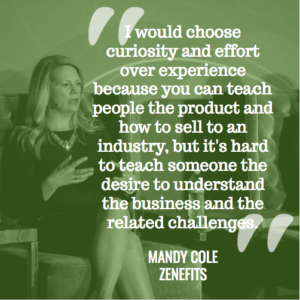
If you get this without this, it doesn’t work, so I would choose the curiosity and the effort over the experience, because you can teach people to sell to an industry, but if they don’t naturally, aren’t wanting to really understand that business, really understand what’s the challenges the business has, how can you solve that, how can they work with them to do that, and build that kind of trust, and they have to do it quickly these days.
You don’t get five calls to do that. You get one. It’s hard to teach that. You can teach them the product. If you’re just hiring your first people, and so you do want some of those people, a lot of times you can find, like Sam was saying, somebody that’s been an SDR for a year or two, and they’re in a place where they’re still waiting, but they’re good.
I would just really drill into them on, tell me about your team? Where do you rank on your team? Go through their pipeline with them. Does that match what you found that you need for yours? We have teams where there’s all sorts of, we have different, varying degrees of people’s effort. You want to make sure that you’re bringing somebody that is really ready to go, and there’s not a space for them there.
Sam: One specific, tactical point that I think about a lot, which is, someone once told me this great phrase, this great quote. “There’s an inverse relationship between the quality of the salesperson and the quality of the product, in many cases.” If you’re looking for people with sales experience, my personal experience is, the big, brand name, Fortune 100 companies, it might feel really safe to hire somebody with experience at one of those companies.
Just remember that they benefited from the air cover that brand, and that reputation produced for them. It’s sometimes better to look for salespeople that have struggled with an inferior product, and that had to work a lot harder, because maybe they weren’t getting a tremendous amount of leads.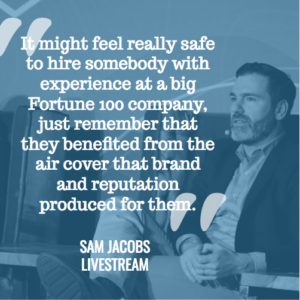
Again, in the spirit of suggestion, look for people that didn’t get everything handed to them as a determining quality for success. If you’re just looking for people that worked at insert the blank, publicly traded, cloud company, I think that sometimes those people aren’t used to what it takes to get a company off the ground that a very early stage.
Mandy: People don’t know what they don’t know. You think you want to do it. You think it’s so exciting, until they’re really in it. And a couple of ways that you can see if they’re saying yes, but they really mean yes, and you guys probably have other ways to do this, too, or actually put them on calls.
Don’t make them take calls, but sit them with somebody, or with you, because you won’t have this whole regimented process that they probably came from, and all of the sales tools. See how they react to that. If they’re concerned that they’re not going to get enough leads, or concerned versus, “Wow, what if we talked about it like this?”
You’ll be able to see their natural reaction in that environment. The other thing is, just ask them right now. When you leave work, tell me about the last awesome day you had at work, and what three things happened that day. Did they find a new customer, find an opportunity, solve a customer’s problem?
Was it someone’s birthday, and they got cake, and they found out that they were going to get two times more leads, so they don’t have to prospect anymore? Sometimes people won’t think about filtering that, when they answer that question. You can see if it actually matches what’s actually going on in your day to day organization.
Brendon: Sam, getting back to your point, other than looking at the graduating roster of small college football teams in the New York, tri state area.
Sam: Holy Cross is a good one.
[laughter]
Brendon: Got it. I’m going to start that one. Unfortunately, there’s not a lot of small colleges in California, but where do you find these people?
Sam: It’s sort of like the answer to content marketing, where do you find your leads? One place you can find them is very, very effective recruiters. That’s obviously one place you can find them. The second most obvious answer is you can find them on LinkedIn.
The third obvious answer is you can find them by building relationships with undergraduate schools, where people are coming out of undergraduate programs. The fourth obvious answer is, you can look at companies you want to emulate, that aren’t doing so well, and you can start to recruit those employees.
The real answer, to build a long term, sustainable sales brand for your company is you, as the VP of sales, need to be somebody that people want to work for. That means that your company, it’s not just the company, because sales is a specific function within the broader mission of the company.
There’s a halo effect around the mission of the company, so if people really identify with whatever the company is doing, yes, you’re going to get applicants. The other thing that people want to have to believe is they have to believe that you, as a VP of sales, or you, as a sales organization are going to help improve their career, teach them something.
That’s where, essentially it’s a form of content marketing. An example is, at LiveStream we run the Brooklyn sales meetup. We do that intentionally to share best practices, because we’re all passionate about building a really high quality community of sales professionals in New York, but we also do that, frankly, because it shows that we really, really care about professional development, and that helps us attract applicants over time.
In the absence of that, which is a long term, multi year mission, there’s a couple obvious places. One of them is companies that have large sales organizations, many of which have high turnover, but can train people really well, so you can get the benefit of that.
Then recruiters are, I believe in the value of talented intermediaries to help us grow and scale a business. Companies like Bets, or HireKeep, which is a recruiter that we use, those are great places to go.
Brendon: A question for either of you, looking at obviously the bulk. Many of the people that we’re working with were managing today our Millennials, from this newer generation. I’m not sure what the Millennial age range is, actually. Somebody told me it was up to 40. If that’s the case, I’m not entirely sure.
Audience Member: ’81.
Brendon: What is it?
Audience Member: ’81.
Brendon: ’81, got it. It’s different. It’s a different set of values, motives, etc. It’s just different personality, managing Millennials early in their sales career. Do you notice anything different about what drives them, versus maybe the people that we’ve hired and managed in the past? This is really for either of you.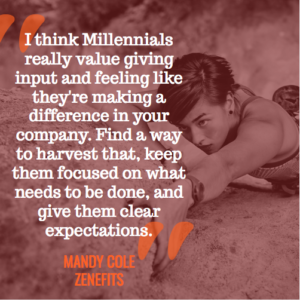
Mandy: Sure. There are a couple things that are a little bit different. I think they really value giving input, and they value feeling like they’re making a difference in your company. They want to know, “What am I doing every day that’s making a difference?” I want to share my input, and what I think could help.
It’s finding a way to harness that, but then also keep them focused on the things that need to happen every day, to make sure you have that pipeline. If you can make sure when you’re structuring it, I think they need clear expectations, too. They don’t like their cheese to be moved.
I don’t think most people do, but definitely, I would be careful in hiring. From experience, don’t say, “Oh yeah, if you work really hard, you can get promoted in three months.” It’ll be latched on. Then if you decide it’s going to change it is really hard to get over that. I would really try and keep that…
Be as honest as you can about the opportunity, but really play up the, “You can learn a lot here. You’re going to be able to get exposure to things that you wouldn’t get just going to a big company,” or, “This is your role and everything’s preset and there’s no determination, but here’s how you’re going to do it.”
Then find ways to construct, basically construct a way for them to give input on the things you really want. Instead of just making it a free for all, “Always give us a feedback,” say, “Hey, it sounds like everyone here’s the biggest challenge we’re having right now. Let’s get people together.”
“Why don’t you guys come back with two opportunities?” It’s amazing how fired up that gets people, and it’s also helping you solve a problem and keeping people focused on their main goal.
Sam: I agree with everything Mandy said. I think, again, some of this stuff is cliché to me and probably some of us because we talk about it all the time, but maybe it’s illuminating for the folks in the audience.
There’s this famous Dan Pink TED Talk about what motivates really anybody. I would say millennials are perfectly suited for this example which is it’s three factors: autonomy, mastery, and purpose.
I think it’s the responsibility of us as managers to clarify and communicate the purpose of the organization. What is the mission? Where are we going? That’s something that you cannot do often enough.
You have to do it so many times that it feels exhausting and you feel like you’re repeating yourself. What is the point of why we’re all here? I think that’s something millennials and anybody wants to identify with.
Mastery really just means you’re going to invest in them, and you’re going to give them the opportunity to get better at what they want to do. Then autonomy, again, is it’s not about leaving them alone. It’s about setting clear expectations so that they know what they’re supposed to do every day.
The other thing I would say…and the best example of this is Yelp. They have a nice sales team in New York, and I’m a big believer in it. The headline is, “Create a Professional Development Path,” which sounds, perhaps obvious.
But everyone wants to feel like they’re making progress towards a destination in their career, and Yelp has done an incredible job which I basically copied in my VP of sales roles at Livestream and previous companies.
Mandy: Me, too.
Sam: Millennials, they want feedback. They want to know that they’re moving along so you have to create a progression through which they can get promoted. It’s different than maybe for some of us it was 10 or 15 years ago.
Promotions are not something that I think are going to happen every three or four years for young people. I think they want to know there’s a sequence of promotions over sometimes six to nine months.
For example, at Livestream you come in as an inbound SDR and Mandy’s right. You can’t say a number that’s too long, but really you’re going to do that for six to nine months. Then after you become an inbound SDR you’re going to pick a path.
You can become an inbound account executive. You can become an outbound SDR, because we actually say being an outbound SDR is the equivalent difficulty rating of an inbound account executive. Or you can actually move towards account management customer success, which is still a part of the commercial organization.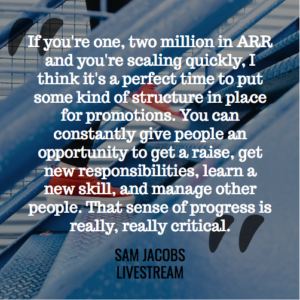
There’s levels and levels, and Yelp has SDR1, SDR2, AE1, AE2, and the whole point is that you can constantly give people an opportunity to get a raise, get new responsibilities, learn a new skill, manage other people. That sense of progress is really, really critical.
If you’re 50,000 in MRR it may be a little early to install a rigorous professional development path, but if you’re one, two million in ARR and you’re scaling quickly, I think it’s a perfect time to put some kind of structure in place.
Brendon: Got it. I think we’re about halfway through so probably an appropriate time for us to take some questions from the audience. We’ll let you guys go.
Audience Member: I was just going to ask you about the best tips for recruiting new sales reps when you’re a young starter company, especially when you’ve had a mixed experience of hiring sales reps that weren’t a good fit. What’s the best tips for in that kind of interview process working out who is the best fit for the business in the long run?
Mandy: Best fit for the long run. If you’ve hired some people that you feel like aren’t the best fit, first maybe take a step back and figure out, which you’re probably doing now, what that is, and even ask if you have or know other people that are in sales or leading sales organizations.
I know, and I’m sure you guys, too, people reach out to me a lot saying, “Hey, here’s where I am. What do you think?” People are always willing to share. I’m sure you’re getting that here.
Once you get that it’ll help you target better where those people are, and if it is somebody that… I want somebody more early stage and what kind of experience level do they have and then what…I think of it from a can do, will do and fit.
Can they do the job? What kind of experience or skill level do you think they have that job? Will they? That’s the effort piece that you don’t know until you talk to them. Then are they a fit for your organization? Are they flexible? Are they willing to grow? Are they willing to do a little more than their job?
Then finding those people I think it goes back to what Sam was talking about. You can definitely…they’re online. You can use a recruiter. You can start to do just some networking on your own.
Something that’s been successful for me in our past two roles is actually doing open houses where we…I’ve used my reps to do this, too, but reaching out to people and just…at a lot of places there’s different sales organizations and groups you can find them on LinkedIn. You can find them a bunch of places.
Posting that you’re having just a casual meet and greet open house and beer and food. That brings them in. Then you get to meet some of them there, too. That’s something I’ve seen be successful outside of some of the channels we already talked about.
Sam: I would also say…again, some of this is…it doesn’t mean to come across New Age-y, but figure out what you believe. Figure out what your values are and write them down so that you can communicate them to the people that you’re trying to recruit.
What we’ve done at Livestream we’ve posted a representation of what we believe is important at a sales organization. I’ve got it on my LinkedIn. People and candidates can find it and go through it.
But the first thing you want to be able to do is…because I don’t think finding talented people is the hardest part of it. The hardest part of it is that you have to convince those people that they should work for you.
You should write down what you believe. You should write down why your company is special, what your mission is, and you should prepared to defend that. If you can inspire them through that I think you have a good opportunity to recruit them. In the absence of that you don’t have any collateral. You don’t have any support to reinforce the message that you want around the candidates.
Audience Member: Question, when you get to a scale that you need a sales management layer, could you share some best practices? Do you promote from within? Sometimes the best salesperson isn’t the best manager. Do you bring people in from the outside? What do you do in that situation?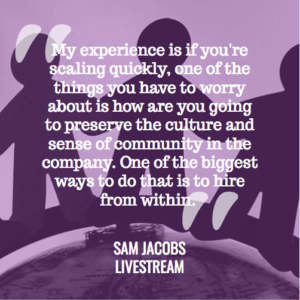
Sam: My experience is if you’re scaling quickly one of the things you have to worry about is how are you going to preserve culture and preserve the sense of community in the company? The biggest way that I do that, there’s two ways, and one of them is hire from within.
My rule is 80/20. My rule is 80 percent of your promotions should come from within the company and 20 percent should come opportunistically from outside, because you never want to make a set rule.
But, yes, it’s true, and you’re constantly going to read about people that tell you that a great individual contributor might not become a great manager, but if you’ve read the Andy Grove’s High Output Management, he’ll tell you, “What else are you supposed to do?”
Because you need to be able to demonstrate to everybody else in the company that this person that you’re putting in a management position has the credibility because they’ve done it in the past to teach other people how to do it.
I strongly prefer to promote from within whenever you can, and again it’s about 80 percent of the time. I do it because they’re going to have credibility. They know the culture. They have institutional knowledge, and also because it preserves the other aspects of the company that you think are important.
The second way to preserve culture as you grow, it wasn’t what you asked, but just as a tip, is to keep distilling and forcing down, basically create small teams as big teams get bigger. As the number of direct reports for a sales manager expands create smaller pods or small teams.
That helps drive accountability, and, again, to Mandy’s point, people want to feel like they’re contributing and accomplishing, and if they feel like they’re a team of 20 SDRs they might not feel that sense of ownership around the outcome of the business.
If they feel like they’re a group of three people responsible for driving a specific ARR goal they’ll perhaps behave with more autonomy around the business.
Brendon: Yes. Just one point I’ll add. I do think when you’re unflattening the sales organization you definitely can…you know who you want to promote probably fairly quickly, but you can promote too quickly.
Like if someone comes in, they crush it for a quarter, and then you move out and they manage a team of 5 or 10 people, they have to have proven it over a period time for me, ideally two years, maybe one year.
I definitely get with the hyper scale model that that period gets accelerated. That can create problems when you’re forced to move people up too quickly. I do think they have to have proven themselves over some period of time.
But I definitely think promote from within absolutely has to be the mandate. It will become part of your hiring brand as well. People are going to come in and know. It reinforces the concept of a meritocracy. Those that perform and prove themselves over time are the people that are going to be given the first opportunity to move up in the organization.
You can’t ask for much more than that. There’s no political or bureaucratic element to it. It’s those that perform and prove themselves are the people that move up, and I think if you have that that’s a pretty functional sales org.
Audience Member: For quick context I run a team of eight sales reps and then four SDRs, and the thing so far…we’re starting to scale really well. The thing I’ve done well so far has been taking a 22 to 24 year old straight out of college and turning them into a rep that really follows the predictable process.
I’ve got seven of my eight are those and then the four in my farm system from SDR is on. I’ve got a pretty system going. My question as I hit this new phase of scale, am I going to run into barriers having a system that only has 22?
Basically I take people with no experience and turn them into sales reps. Is that a flag as I get…so next year I’ll probably double the sales team. Is that scalable or should I start expanding?
Mandy: It depends on if you decide to…what your market approach is. If you’re now going to go sell a different customer size or a different industry and you feel like you need somebody different that’s something you’d have to evaluate.
If you feel like, look, I’ve got plenty of market opportunity, I just need more people, and this works fine…that’s how Yelp grew their team. It wasn’t necessarily their whole model was that, and it worked.
If it’s working for you and you don’t see anything coming up around changes in your product or your market opportunity that would then cause you to think you need somebody with a different skill set I wouldn’t worry about that.
The one thing I would make sure you do is be thinking about now are there people on your team that could then become a manager? How do you put that carrot out in front of them? To Brendon’s point about, “Hey, if I see these things from you in the next six months,” and do you have somebody you can grow within?
If not that might be the other reason why you would want to hire somebody and go ahead and have them start in sales but that has a little more experience that you feel could grow into that so they still come up with a team and get that experience, but you have some more bench strength on your management side.
Brendon: Yes. I think the only issue would be, and I’m not sure what your SDRs are…are they entirely outbound?
Audience Member: Yes. They’re a hybrid, 70 percent outbound, 25 percent inbound.
Brendon: I would say, if it’s primarily outbound, then you can continue down that track, within reason, where you can manufacture the demand. If your SDRs are inbound SDRs, then there’s an element outside of your control which is going to be, “Hey, if our demand model doesn’t scale, or our marketing demand model doesn’t scale, then it doesn’t scale.”
If you can continue to manufacture that demand through an outbound model, I don’t see any reason to be overly concerned about it. I think when you’re talking about hiring more experienced salespeople, I think that was part of your question, you probably layer that in later. Maybe it’s you move in up market, or segment, or do those kind of things.
Generally speaking, in a start up, I think everybody knows the Oracle, SalesForce, you don’t want to hire those people, right? It’s a tough standard, because you say, “Hey, I don’t want to hire big company people. That’s not a fit for a startup.”
What do I want? I want people that have proven themselves, and have done it on the ground floor of a successful startup. There’s not that many people who have done that, so if you X out those two and say, “Hey, there’s going to be a limited supply of that,” then you’re really just looking for raw talent on some level. I think if you continue to keep that pipeline going, that’s a great place to be.
Sam: I think you’re doing it the right way. If you can take people that don’t have sales experience and turn them into performing reps at quota, then you’re building a sustainable, long term business. If you’re constantly dependent on the next rock star that you’re able to recruit away from XYZ company, that’s definitionally not sustainable.
The other thing I would say, one of my favorite little anecdotes is a buddy of mine who works at Lux Capital says, “Any time I get to look at a deal in the venture business, you always have to ask yourself, why do I get to look at this deal? What happened before this deal landed on my desk?”
I think about that every time I interview a salesperson, that you look at their resume, they were the top performing rep at insert the blank company. They crossed quota three quarters in a row, they were a member of the president’s club. If all of those things are true, because I’ll tell you that my top reps, I’m doing everything I can to make sure they’re excited, they’re happy, they’re fulfilled.
They feel like, I’m constantly worried. What do they want for their career? What do they want for themselves? When I get to interview the person, I’m asking myself, “Why do I get to interview you? What’s going on that you’re not telling me, that I get to sit in front of you right now and talk to you about why you want to join LiveStream?”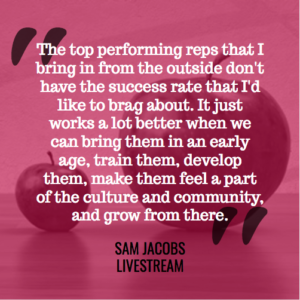
That bears out, in my experience. Again, the reps that I bring in from the outside, that are top performing, I have to say, I don’t have the success rate that I’d like to brag about. It just works a lot better when we can bring them in an early age, train them, develop them, make them feel a part of the culture and community, and grow from there.
Brendon: I’m going to go back to the point of the SalesForce, Oracle, SAP model. I think it’s, I’ve actually hired a lot of great, young salespeople that started there for maybe a year or two, and then said, “God, I don’t want to just be a name or a number here.”
Mandy: Forever.
Brendon: It’s the people that are institutionalized in that big company, in that big company culture, and having that brand behind them. That’s what I try to avoid, personally, is people that only know the experience of waking up and being number one in their space, with no competition.
I call it “Woke up on third base and thought you hit a triple” syndrome. Actually I didn’t make that up, I stole that from someone, but I think that’s the mentality around it. Getting someone one or two, or three years out of Oracle with a lot of great experience, and bringing those people in where they get some exposure to the process and structure, but understood that they didn’t want to be a part of that machine for the next 10 years of their life.
Mandy: A lot of people will go there because they think, “I need to have that experience to get another job.” So, I agree with that.
Audience Member: Hi, quick question on compensation packages. What are your best practices for hiring entry level salespeople?
Sam: Three quarters… Entry level salespeople, I would define as SDRs, and for them, it’s three quarters base, one quarter commission, roughly. You can play with those percentages. For SDRs, I’ve done some research on this. There is no set way to do it, but the traditional, for what that’s worth, which probably means the plurality, but perhaps not the majority.
The plurality is 50/50, a mix of creation of sales qualified opportunities in a given time period, and then 50 percent the revenue that’s closed from those sales qualified opportunities. My last shop, it was 100 percent closed revenue. We had no focus on number of leads created. I’ve seen places where it was 100 percent the number of flips or leads that you create, the SQOs that you create.
I like 50/50 as a mix. The SDRs, and some people might tell you we don’t have any control over if the business closes. If I flip to a rep they can’t close the business, that’s not really fair. My general answer is, “Life’s not fair. We’re all accountable to the results of company, and to our shareholders.”
It’s just something that, we’re all going to have goals and metrics that aren’t 100 percent within our control. I’d also just like to have the SDRs looking down the pipe, and making sure that they’re focused on what happens to the flip, not just creating it.
Mandy: That’s why the SDR role is so great. It’s your ability, too, to weed out, to find the people who are going to be the people on your sales team. If somebody is not going to be a great fit for that, you can discover that before you put them on the floor, and so it’s going to increase the longevity.
I found in our teams that people that we promote from SDR hit the ground running. From an ROI perspective, they are bringing in the most revenue for the company, and they stay longer. Their retention on them is longer, because they made it through this pathway, and they feel proud of that.
It depends on who you are, in terms of what you need to focus on, and sometimes people will start just on creating opportunities. I think if you do that, you have to be very structured, and an opportunity that I will pay you, looks like this.
These industries, set in this time, with these decision makers, so that you don’t just have people gaming the system, and then you create this dynamic between your sales team where they’re upset because they’re not getting the right things.
Longer term, you do need to tie it to that, because that’s the only way they’re going to learn. Not the only way, but a big way that they’ll learn, this is how it is, building my own pipeline. I’m going to have to eat what I kill soon, and if I’m not good at putting things on somebody else’s calendar that are good, and doing that consistently, why would they do something different for themselves?
Sam: The last thing, again, tactics. Monthly commissions, really strongly believe you should pay monthly. It obviously depends on the length of the sales cycle. If it’s a true enterprise sale, and it’s six months, million dollar deals, maybe not.
This may not even be a point of dispute or debate, but if you pay quarterly, then obviously a big percentage of your sales are going to happen in the last week of the quarter. This way, you can just compress that, so that most of your sales in a month happen in the last week of the month. We have a whole structure at LiveStream about how to manage for the last week of the month, which works pretty well.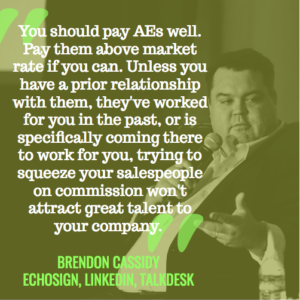
Brendon: Yeah, I think AEs, generally speaking, pay well, I think is the general concept that, pay them above market rate if you can. Make sure they’re profitable, make sure it’s not a cost setter, but there’s just so many options out there. Unless you have a prior relationship, or somebody that knows you, has worked for you in the past, or specifically is coming there to work for you, trying to squeeze your salespeople on commission is just going to be a self fulfilling prophecy.
It’s like a death cycle. You’re just not going to get great talent to work for you. You certainly can hire young talent that you can develop, but ultimately, once they develop, they’re just going to go find a higher paying sales job. My advice is to pay well within the structure that ensures that salespeople are profitable, but that’s my philosophy.
Sam: Who chooses who answers? [laughs]
Mandy: I know.
Brendon: Use your best judgement.
Audience Member: Hi, how you doing? Thank you very much. My name’s Andy, and I’m from the iPad Receptionist. We’ve gotten to about 40k in MRR, brought in two different account executives. This is my first SaaS startup, and I’ve been struggling with, how do you actually deal with territory versus specialization?
Do you actually provide a territory for person, or do you work on specialization where there’s different people, and everyone is working nationally, or whatever? I’ve always struggled with territory, if you guys help me with that.
Sam: My answer is, it depends on the nature of the business. If you’re getting a lot of inbound leads, then territories don’t make a lot of sense. Territories, again, my experience, Brendon and Mandy work at companies with very, very large, they both have experience with companies with very large sales organizations.
My experience is, territories develop over time, but that initially, the ocean is so big that you can focus on a specialization or an industry vertical. If you’re getting inbound leads, again, it doesn’t really make sense, because you just want to divide those as evenly as possible, if you think the reps are of equal talent.
Territories evolve once you feel like you’ve hit true scale, and you need to squeeze every last drop of revenue out of each geography ZIP code. In Yelp’s case, or some of these SMB businesses, it’s down to, you worked at Main Street Hub, it’s down to the ZIP code, and the city block, etc.
My experience is, focus on verticals and ICP, ideal customer profile. If you only have two reps, I don’t think you need that yet. If you have 10 reps, and it’s a longer sales cycle, and you really have to get to know the account really well, that’s probably the point at which geography matters little bit more.
Field sales, obviously it’s going to matter a lot, because they need to visit them in person. Inside sales, that’s one of the benefits, is that they can call anybody. If you’re going to do a territory, it may just be East Coast, West Coast, or something like that.
Brendon: It also depends, are you asking your, I think you said two salespeople, is that right? Are you asking them to develop and build all their own pipeline, or do they have SDRs that are supporting them?
Audience Member: Right now, we’re just working on inbound leads, and I’m still building the outbound sales. The reason I actually ended up splitting them between East Coast time zones and then the three West, mostly just because we’re in Colorado, so somebody’s got to be up at seven o’clock in the morning, handling leads. Somebody’s working later to handle the West Coast leads.
Brendon: Congratulations. It sounds that you have some leads, that’s good.
Audience Member: We do.
[crosstalk]
Sam: Leads are job one.
Brendon: That’s step one.
Brendon: I would say that’s one of the common mistakes I see in a lot of big company sales executives that try to do startups, is putting in territory structures as if they’re a big company. Again, people are creatures of habit, they going to do what they know. A lot of times, really up until about $10 million in ARR, it does not make any sense, unless you’re asking your salespeople to drive all of their own pipeline.
Again, most people understand today you have to segment. You have to create demand, whether that’s through marketing or through SDR. It’s tough to ask your AEs to create their own pipeline. The best AEs can do their own prospecting, it just doesn’t scale.
If you assume that those are segmented, again, every situation is different, but eight or nine times out of 10, it is not stage appropriate. That’s one of the common mistakes big company sales execs make over, and over, and over again, and it could kill you.
I was in a startup where literally 80 percent of the opportunity was in 20 percent of the territory, and they had reps in Kansas and Oklahoma. They have 80 percent of the reps literally have zero deal flow. It’s like, “Hey, the rep in the Bay Area and the rep in New York are crushing you.”
That’s no surprise. That’s where 100 percent of the leads are. Stuff like that, it’s common sense. I know you were in SalesForce for 10 years, congrats, but not appropriate for where we are.
Sam: Brendon, you get to pick.
Brendon: Let’s go up here.
Sam: Mr. Moderator.
Audience Member: A question about offboarding sales reps. When do you identify the sales rep is not working out? What are the main things that you’re seeing, and how do you offboard them?
Sam: Main things we look for are quota attainment. It’s not it. He said, “Is that it? Is it only quota?” No, that’s not it Obviously, if somebody, there are superficial qualities, like people are working really hard. They appear to be doing a lot. You can look in SalesForce and their activity levels are high.
This is a whole management conversation, essentially, as people say, is it that they can’t do it, or they don’t want to do it? If they can’t do it, then you need to teach them, and they need to figure out, are they coachable are they teachable?
If they can’t do it and they’re not coachable, then you’ve made likely a bad hire. If they can’t do it, but they’re willing to learn through interaction, then maybe you need to invest more in coaching them and developing them.
If they don’t want to do it, that’s a 50/50 relationship where you have to figure out, what kind of culture are you setting where you’re not motivating people, and then you have to figure out if this is the bad Millennial or the good Millennial, because they tend to be binary.
I just say, we work on monthly commissions. I have a deck. The other thing is, clarify expectations. What’s expected of me? That’s the number one question people ask in First Break All the Rules, a great book. First thing is, you’re allowed to miss. Hit quota, green light. Miss quota once, yellow light.
You’re allowed to miss quota one month out of a quarter, or out of four. It depends on what you expect quota to be, and then if you miss quota two months in a row, red light. That’s bad. If you miss quota three months in a row, you’ve missed quota.
Again, I’m defining quota as essentially the 80th percentile, or the 20th. 80 percent of the reps should be at or above quota. Some people set quota so that only 10 percent of people can attain it. If you’re using it as my framework, which is that most of the time, and I’m doing this obviously because I’m cutting the revenue plan, and I want to make sure that I don’t stretch ourselves when it comes to revenue projections.
If quota is where 80 percent of the people should be at any given time, then you can miss it one month. You’re in trouble two months, and I’m starting to look at those qualitative characteristics, like are you engaged at work? Are you coming in on time? Are you doing good stuff? What’s your activity levels in SalesForce? Then, three months is the time to, as you say, off board them.
Brendon: If you don’t get them, if the light bulb’s not on by three or four months in, it’s not coming on, probably. [laughs] You have to have a little bit of flexibility in a startup, especially where there is probably not a lot of historical data to say, “Hey, this is what success is here over 36…”
This company hasn’t been around 36 months, but I think if you don’t see that upward arc by their third full month in, then some people just take a little bit longer, and I think that’s why you don’t fire somebody at three months in. That’s red flag.
It’s a concern, and then something happened in on boarding, or you just didn’t hire the right person, but you have to go back and double down, essentially at that point, and try and see if you can get them on the curve again.
Mandy: Setting those expectations actually makes it easier to off board. If you don’t know, if you’re still playing with what your quota is, you can at least say, “Look, this is the consistent performance around activity.” You need to be creating this many opportunities a week, or setting this many demos a week.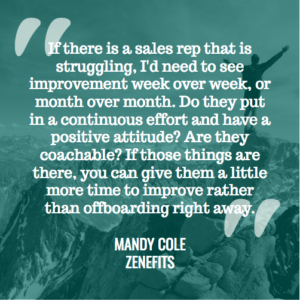
Then you can back into what they need to do to do that. I need to see improvement on that, week over week, or month over month. I look for those things, if quota isn’t quite there. Do they have continuous effort, and do they have positive attitude? Are they coachable? If those things are there, you can give them a little more time.
You are still going to have some people that eventually, like Brendon is saying, it’s just not the right fit for them, but if you set that up, and you’re having that conversation continuously, what you’ll find is that person gets frustrated, and it’s a little easier to say, “Let’s just check in. How are you feeling? We’ve worked on this, we’ve worked on this. What do you think?”
A lot of times, you’ll find, “Is this really the right fit for you? I want you to be happy. I want you to be in a role where you’re striving, and boy, you’ve tried X, Y, and Z, doesn’t seem to be working.” A lot of times, you’ll find that person takes themselves out.
Brendon: Yeah, I think just the last point, it reinforces for me. Again, I know Sam, we have the non solicit issue, so that exception aside, hiring, if you can hire three or five people, truly vetted in your network, or have worked for you before, early, it just removes a ton of drama in the early stages.
At TalkDesk, we hired Paul Donati, who is the number one rep in the history of EchoSign. Literally, his first full month, he closed like 100k. That’s very abnormal, but if you can get those people in, they can hit the ground running and be super productive, maybe without even knowing the entire market first.
I think that’s a huge advantage, and for me, that’s why I always carry that list around in my pocket, which is, “Hey, who’s the three to five people? Who’s your dream team?” Whatever that scenario is. Go ahead.
Audience Member: Hi. First off, I wanted to thank you guys for this panel. It’s been extremely informative. Currently, our product is a construction project management, big data analytics solution. It requires a lot of product knowledge. I find it very analogous to healthcare in many ways. There’s a lot of intricacies involved.
We’re looking to hire our first sales hire, and there’s two camps, I think that exist within our organization, which is, “Let’s hire people with previous industry experience, guys that have been out on projects, in the fields.” My camp is, we can train them appropriately to learn the product, and then we rely more on the traits that you guys mentioned, which is somebody that played for a D3 team in college, but is a real go getter, is resilient.
That’s my camp. If you were to hire your first.
Brendon: I think we said D2, not D3.
Audience Member: D2, oh sorry. D2.
Brendon: We don’t want D3 players.
[laughter]
Audience Member: Yeah, if you guys were to hire your first sales hires, we’re in a sprint right now to gain more users, to get more product feedback before we have commercial launch, like everybody else, I’m sure. Would you put more weight on the traits that you guys mentioned, and/or with limited resources, go with the hire that has the really great resume of selling in the enterprise space, but doesn’t know this industry that well?
Brendon: What does he give you? What does he or she, the big resume give you that’s…I know that’s not your camp, but what do they give you that’s appealing?
Audience Member: Essentially, somebody that has consistently either hit and or exceeded their quota numbers, perhaps has sold a product that may have been a shitty product, quite frankly. Excuse my French, but I feel like the ones that can sell a crappy product are probably going to be the best salespeople…
Sam: I agree with you.
Audience Member: …and have done really well with it. That’s more my camp.
Sam: You need somebody at the company that can…Maybe it’s you. I don’t know how big the organization is, but if there’s somebody that’s doing something else, maybe it’s like somebody in product that can train, coach, and develop somebody, then my advice would be to go for the person that has the fundamental qualities and characteristics that you’re looking for, versus the product knowledge.
But I’m hopeful that the product knowledge exists somewhere else in the organization, and that there’s somebody that is essentially, they don’t define themselves as a salesperson, but they end up in all the meetings. They’re highly commercial. They like talking to people, so even though they haven’t defined themselves as sales, they’re essentially doing the work of salespeople.
If he or she exists in your org, and if that’s you, then I would go for the person with…I mean, they need to be trained by somebody. I don’t think that a 20 year vet of the construction industry sounds like what you need at this point, but I could be wrong.
Audience Member: Thank you.
Mandy: I agree.
Audience Member: Hi there, on your left. Quick question on the cost of sales for startups. If you’re selling into enterprise, any kind of idea on that general percentage, what should be your cost of sales? Or do those metrics even matter at the early stage?
Brendon: I’m sorry, what?
Audience Member: Cost of sales.
[laughter]
Sam: What should the cost of sales be in a startup?
Audience Member: Cost of sales, do those metrics matter…
[crosstalk]
Brendon: I think we’ve heard earlier, 20 percent of your overall investment should be sales and marketing, potentially. If you mean, “what should I pay people,” or…Is that what you’re saying?
Audience Member: If you sell a hundred thousand dollar subscription to an enterprise, what should be your cost of sales?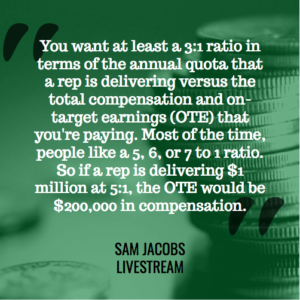
Sam: A couple rules of thumb is, first of all, that you want at least three to one in terms of the annual quota that the rep is delivering versus the total comp and OTE that you’re paying that, and that’s low.
Most of the time, people like to look at five, six, seven to one. That means that if they’re delivering a million dollars, then five to one would be, the OTE would be $200,000 in compensation.
Mandy: I was going to say five.
Sam: There you go. Mandy said hers was five.
Brendon: I wouldn’t be overly worried about that in the early [laughs] stages. I think just getting reps productive and profitable is important, but that’s more something I’d look at when you’re really scaling and unflattening, etc.
Sam: If you’re talking about what percent of the deal you should…so five to one would mean…and that’s including benefits. That’s including everything.
If you’re talking about what’s the payout so that you can make sure you don’t get over your skis because I’ve certainly seen situations where you’re so desperate to get a sale that you’re paying out a disproportionate share of revenue to the rep or to as sales marketing expense.
Ten percent of the deal is a good place to be. Twenty percent is an aggressive place to be. Five percent is a very good place to be if you’re a shareholder and perhaps not a great place to be if you’re the rep, but somewhere around 10, 11, 12 percent is probably what you want to pay out in terms of deal value.
The other thing you just need to make sure is that you’re aligning your business goals with…I’ve seen issues. Just make sure that you’re paying, for example, when cash is collected, that you’re demanding upfront annual payments. Do all the things to help you manage your working capital.
Don’t get your comp structure out of alignment with your business objective so that you’re paying money to the rep before you collect it yourself, for example, which sounds completely obvious. Don’t pay on ARR in my opinion. It has to be a function of ARR with upfront annual payment.
If you’re paying on ARR but you allow the customer to pay quarterly and you’re paying out 15, 10 percent to the rep right away or a month after they close the deal, then you have a working capital situation on your hands where those payments are out of alignment.
Mandy: The payments will also help you retain that rep. You want to make sure to keep it line with when you’re getting the money they’re also building a book a business. It also helps you longer term.
Audience Member: Thanks.
Audience Member: I’ve got a question right here. Sorry. Thanks so much for all of this information. It’s been really insightful.
I’ve heard a couple of different things throughout the panels over the past couple of days in regards to SDR versus AE ratio and would love to get your thoughts and input, especially since right now on our team we’re in a position where we have more AE headcount available than SDRs.
The growth that we’re trying to achieve, the AEs that we’re bringing in with their experience level they don’t necessarily want to do a lot of the outbound effort in building their own pipeline. Do you double down on SDRs?
Maybe reduce one of the AE headcount to hire more SDRs, or do you just work through that load and hope that you’ll eventually get enough SDR support to be able to support those fully ramped AEs? Sorry if that’s complicated.
[laughter]
Mandy: I can talk about that because we have a different SDR to AE model right now. We have two to one. I think…
Sam: Two AEs to one SDR or two…?
Mandy: No, two SDRs to one AE.
Sam: There you go.
Mandy: Where we are right now we have a lot of market opportunity and for us, for a while it was figuring out where in that market opportunity is the most profitable for us. I think now we’re honing in on that and that ratio will probably change in the next six months.
I think if you have the market opportunity and you know that they can sustain the amount of activity, the amount of opportunities to then make the revenue work just like Sam was talking about that you’re going to actually double the revenue from that AE.
Or you’re willing to invest some upfront and getting more market share and eat that a little bit, then it’s worth it. I would think longer term, like if you decide to do that now, what does that look like 6 months or a year though?
Is it a short term problem you’re trying to fix and is there something else you can do to do that? Because hiring people and then managing them and also off board and that’s expensive and it’s time consuming. Make sure to balance those two things.
Sam: The other thing is it’s a math problem. It’s easily solvable. How many opportunities are the SDRs creating? How many opportunities does an AE need? What’s their close rate? What’s the ASP? That’s how much money the AE is going to make every month.
If those figures are out of alignment and the SDRs producing whatever they can produce, whatever that is, if they can produce 10 opportunities but the ACV is too low and the reps can’t hit quota on those 10 opportunities, then you need fewer AEs and more SDRs until you have the leads to support them.
Audience Member: We have a company and we sell to businesses in the tourism space. With the tourism space, you can sell to them pretty well from October through May and then…
[crosstalk]
Brendon: What space is that again?
Audience Member: The tourism space. Then, June through August it’s like nuclear winter. They are ultra busy. The sales cycle becomes extremely hard. In setting quotas with a pretty seasonal selling cycle, do you have any thoughts there because our team has also went from two to nine in the last six months.
Just trying to set the quotas now and make them fair throughout the year and obtainable but having a little bit of trouble with the seasonality.
Sam: I haven’t worked in a business that seasonal. My general rule of thumb is, you have the same quota in August as you do in October, October is typically the busiest month for everybody and August is typically one of the slowest but I don’t like communicating that message to the reps and giving them an excuse not to hit their quota.
However, for every rule there’s an exception. It sounds like your business actually is very, very seasonal. You might need seasonal quotas. You might need different quotas…The only thing you have to do is just make sure you communicate it in advance, obviously.
By the way, maybe there’s a way you can make the business less seasonal. I don’t know what that means. Maybe that means you run certain promotions during the time when normally you can’t get a lot of engagement, maybe you’re offering more free months or more discounts or you’re finding some reason….
Or maybe you just need content marketing to tell these tourism people, now is the time to buy even if they’re very busy.
Brendon: I think we’re over so I think that’s it. Thank you.

